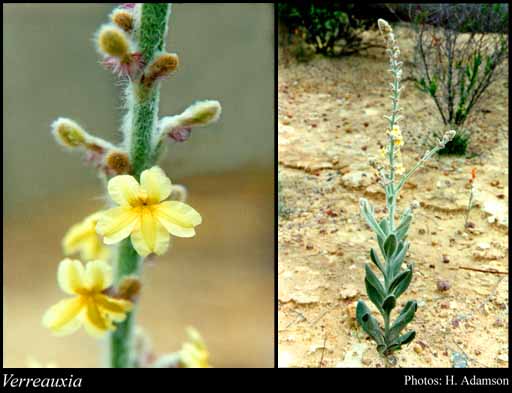This name is not current. Find out more information on related names.
- Reference
- Fl.Austral. 4:105 (1868)
- Name Status
- Not Current







Scientific Description
Common name. Verreauxias. Family Goodeniaceae.
Habit and leaf form. Shrubs, or herbs. Perennial. Leaves basal, or basal and cauline. Plants with a basal concentration of leaves, or with neither basal nor terminal concentrations of leaves. Stem internodes solid (ass.). Mesophytic, or xerophytic. Leaves alternate, or opposite to whorled; spiral; petiolate to sessile; non-sheathing; simple; epulvinate. Leaf blades entire; flat; ovate, or obovate; pinnately veined; cross-venulate; attenuate at the base. Leaves without stipules. Leaf blade margins entire. Leaves without a persistent basal meristem. Leaf anatomy. Hairs present; complex hairs present, or absent. Extra-floral nectaries absent (ass.). Stem anatomy. Secondary thickening absent, or developing from a conventional cambial ring.
Reproductive type, pollination. Fertile flowers hermaphrodite. Unisexual flowers absent. Plants hermaphrodite. Entomophilous. Pollination mechanism conspicuously specialized (involving a stylar modification for pollen presentation).
Inflorescence and flower features. Flowers aggregated in ‘inflorescences’; often in cymes (in a branched thyrse), or in racemes, or in spikes (leafless, or spike-like), or in panicles (leafless). The terminal inflorescence unit cymose, or racemose. Inflorescences scapiflorous, or not scapiflorous; terminal. Flowers pedicellate (shortly, articulate); bracteate (opposite); bracteolate (A); small to medium-sized; very irregular. The floral asymmetry involving the perianth and involving the androecium. Flowers 5 merous; cyclic; tetracyclic. Free hypanthium absent. Perianth with distinct calyx and corolla; (8–)10; 2 -whorled; isomerous, or anisomerous. Calyx present; 5; 1 -whorled; gamosepalous; blunt-lobed; tubular. Corolla present; 5 (unequal); 1 -whorled; not appendiculate; gamopetalous; lobed. Corolla tube adaxially deeply split. Corolla valvate; bilabiate; hairy abaxially; hairy adaxially to glabrous adaxially; yellow, or brown (sometimes brownish outside); not spurred. Androecial members definite in number. Androecium 5. Androecial members free of the perianth, or adnate; all equal (ass.); free of one another; 1 -whorled. Androecium exclusively of fertile stamens. Stamens 5; all more or less similar in shape (ass.); isomerous with the perianth; oppositisepalous (at the base of the corolla); all alternating with the corolla members. Anthers separate from one another; basifixed; dehiscing via longitudinal slits; introrse; tetrasporangiate. Pollen shed in aggregates, or shed as single grains. Gynoecium 2 carpelled. The pistil 1 celled. Gynoecium syncarpous; synstylovarious to eu-syncarpous; inferior. Ovary unilocular; 1 locular. Gynoecium stylate. Styles 1; bearing an ‘indusium’ beneath the stigma. Indusium cupular. Styles apical. Stigmas 1; 2 - lobed. Ovules in the single cavity 1; ascending; non-arillate; anatropous.
Fruit and seed features. Fruit non-fleshy; indehiscent; a nut; 1–2 seeded (per cell). Seeds copiously endospermic. Endosperm oily. Seeds winged, or wingless. Cotyledons 2. Embryo straight.
Special features. The upper lip of the corolla incorporating 2 members, the lower 3; (posterior, adaxial) lip of the corolla entire. Lower (abaxial) lip of the corolla 3 lobed.
Etymology. After Jules P. Verreaux (1807–73), French ornithologist and naturalist; sent by the Museum of Natural History Paris to Tasmania c.1845–50, where he collected a very large number of specimens.
Taxonomic Literature
- Australian Biological Resources Study 1992. Flora of Australia. Volume 35, Brunoniaceae, Goodeniaceae. Australian Govt. Pub. Service.. Canberra..
- Grieve, Brian J.; Blackall, William E. 1982. How to know Western Australian wildflowers : a key to the flora of the extratropical regions of Western Australia. Part IV. University of W.A. Press.. [Perth]..